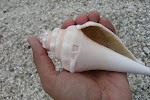I recently found some interesting artifacts that I wanted to talk stories with you about. The artifact on the left is a broken off adze (higam in Chamorro) head made out of a giant clam (hima in Chamorro) shell. I posted my journey in making some higam hima in this post.
At times, when you happen upon broken clam shells, it is hard to distinguish if they are artifacts from the ancient Chamorros. This one was pretty clear in that you can see the straight edges that was worked on as well as the angled cutting edge. I illustrated how the whole adze head could have looked like if it was whole. There are some illustrations here from the The Catalogue of Prehistoric Micronesian Artifacts Housed in Japan (Intoh, May 1998) that I wrote about as well.
Mother's Egg
The artifact on the right is a mystery to me. Some people who have found similarly shaped stones think that they are the ancient Chamorro sling stone is acho' atupat (or atupak). I describe sling stones here when I fashioned some myself. History
books describe them as egg or acorn-shaped stones fashioned with
“jasper-like” stone, or with sun or fire-hardened clay. People now use
the words biconical or football-shaped to describe them. The stone here is really in the "egg-shaped" category.
A few years ago, I saw one displayed in the Saipan Museum that was very smooth and also egg-shaped. A historian that I was acquainted with shared a very interesting theory that he had about these egg-shaped stones. Maybe they are not sling stones. He says that they could possibly be implements used by some of the ancient women to strengthen their pelvic muscles, much like modern day Kegel exercises. Smiling, I had to ask how he came about that seemingly off-beat theory. He asked if I ever wondered about the expression, i chada nana mu? I told him that I know that it is the most offensive thing you can say to someone in the Chamorro language but literally, it translates to, "your mother's egg". He asked me to consider the meaning of the expression now with this theory. Interesting, yes? Anyway, I didn't get to ask him if there were any other evidence in stories or in literature that may support his hypothesis. What do you think?
Thank you for talking stories with me again.
Ti napu.
The Beachcomber
Subscribe to:
Post Comments (Atom)





5 comments:
Glad you're back. It's especially nice to hear stories from my island home again!
I think this could easily be a sling stone, with very good flight properties and deliveryn high energy on impact. what sizes and weight does it have?
Chada nanamu I remember as fighting words!
Taotao Malesso 1967-1972. Scotty W
Finding that (as slingstones)these shapes with weight forward engineering, these actually fly faster and further anam the symmetrical biconical shape.
These shapes were formally regarded as inferior craftsmanship but from the recent spike in slinging IQ, the many assymetrical artifacts recovered showcase a sophisticated understanding of aerodynamics
Nice post also check btl emsella treatment in Ghatkopar
Post a Comment